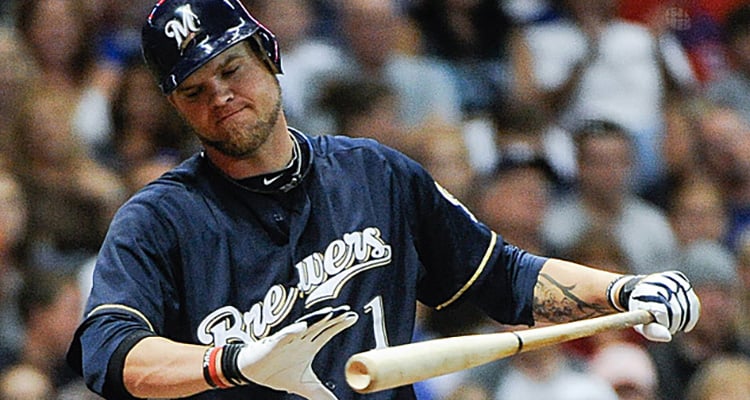The Milwaukee Brewers open a homestand Friday night with a special occasion: They’re welcoming back Corey Hart with a one-day contract, retirement ceremony and induction into the team’s Wall Of Honor outside Miller Park. Hart played parts of nine seasons as a Brewer and is one of the organization’s top 15 players of all time in terms of home runs (11th most), runs scored (11th), hits (14th), runs batted in (14th), stolen bases (14th) and games played (15th). He also appeared in two All-Star Games and easily clears the Brewers’ established criteria of 2000 plate appearances for hitters that’s necessary to earn a place on the wall. His plaque will become just the second added to the area outside Miller Park’s left field entrance since it was established in 2014 (joining TV analyst Bill Schroeder, who was inducted in 2015).
As is the way of the internet, however, conversation around this event quickly shifted from a celebration of Hart’s career in Milwaukee to a rehashing of all the things Brewers fans didn’t or still don’t like about the streaky slugger. Let’s take a look at some of the reasons that not everyone “Harts” Corey.
Cold streaks at the worst possible times
Hart’s best major league season came in 2007, his first as a full-time major leaguer and the Brewers’ first over-.500 season in 15 years. He followed that up with his first All-Star selection in 2008, before a dreadful dip in second half production that coincided with his team’s first postseason run in 26 years.
Hart limped into that All-Star Game in the midst of a two-for-20 slump and proceeded to carry that lack of momentum through the rest of the season. He was batting .299 with a .337 on-base percentage and .515 slugging on July 7, 2008, but hit just .230/.255/.391 over his final 69 regular season games, eventually finishing the year with a brutal .300 on-base percentage. Interim manager Dale Sveum still started Hart in right field in all four NLDS games, including one where he came to the plate following a bases loaded walk in the first inning, swung at the first pitch and grounded weakly to the pitcher to start a 1-2-3 double play. The Brewers went on to lose that game 5-2 and it’s possible that first inning at-bat remains Hart’s defining moment.
Too honest for his own good
During that same slump in 2008, Hart made the first of several ill-advised comments to the media. After a homestand in which the Brewers lost seven of 10 games and put a serious dent in their playoff hopes, Hart told reporters that he and his teammates were “looser on the road” because of fans booing their poor performances at home. Hart made those comments on September 11, 2008, the first day of what would be a decidedly-not-loose 2-8 road trip.
A couple years later, Hart made headlines in spring training when he revealed that he had been playing with less than 20/20 vision in 2009 but “didn’t think it was that big of a deal.” He was later fitted for goggles to correct his vision…but didn’t wear them.
Early in 2012, Hart made headlines again following longtime teammate Prince Fielder’s departure for Detroit as a free agent. When asked about losing Fielder as a clubhouse leader, Hart made comments that could have been construed as critical of Fielder’s value in that role.
Over his time in Milwaukee, Hart developed a reputation as a favorite of the local media because he was honest and could sometimes be counted upon to say the things many of his teammates were also thinking but knew better than to say publicly. Hart’s straightforward answers may have been a good thing for the local scribes, but they weren’t always a positive for his public perception.
A reputation for bad swings
FanGraphs statistics suggest Hart was about league average in O-Swing% (the percentage of pitches outside of the strike zone that a batter swings at) for most of his Brewers tenure, with the exception of the aforementioned 2008 season, where he swung at roughly a third of all pitches out of the zone, as compared to a sub-25 percent league average. That reputation for taking bad hacks at pitches he had no chance of reaching followed him throughout his time in Milwaukee, and both Seattle and Pittsburgh thereafter.
The first base debacle of 2013
Hart’s public comments created a challenge again in 2013, when injury issues stemming from his offseason workouts led to knee surgery that caused him to open the season on the disabled list. After initially telling the media that he was a fast healer and expected to be back in May, Hart ended up pushing that timetable back a couple of times before eventually missing the entire season and leaving the Brewers with virtually nonexistent production at first base. The regulars who took his place at the position included veteran journeyman middle infielders Yuniesky Betancourt and Alex Gonzalez, as well as high-strikeout slugger Juan Francisco. The group combined to hit just .206 with a .250 on-base and .370 slugging. At one point in late June, Brewers first basemen were very nearly being outhit by Brewers pitchers. The Brewers’ inability to replace Hart wasn’t Hart’s fault, of course, but the May prognosis he issued publicly certainly didn’t exactly help propel a search for a capable replacement.
Hart’s contract with the Brewers expired following the season and he returned to baseball activity with the Mariners. In Seattle, he was primarily a designated hitter in 2014 and never regained his previous levels of productivity. Today, four seasons after his departure and five since he last played in a Milwaukee uniform, the Brewers organization, media, and fans will come together to honor Corey Hart for his career with the Brew Crew. All things considered, it featured much more good than bad. It wasn’t all good, though. Unfortunately, some of the unsavory aspects are what many fans will remember most.

